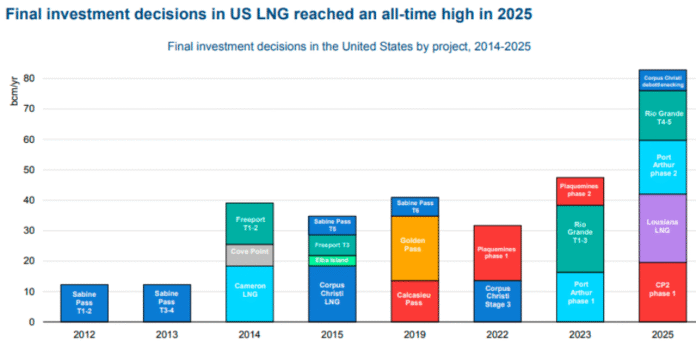Global gas markets are poised for a dramatic transformation by the end of this decade, driven by an unprecedented surge in liquefied natural gas (LNG) production capacity, according to the International Energy Agency’s (IEA) Gas 2025 report.
The latest medium-term outlook projects that around 300 billion cubic metres (bcm) of new LNG export capacity will be added worldwide by 2030 — a record increase that is expected to rebalance supply, ease price pressures, and reshape global energy trade patterns.
U.S. and Qatar Lead the LNG Expansion Wave
The IEA report highlights that the United States and Qatar will account for nearly 70 percent of new global LNG liquefaction capacity. The U.S. alone has sanctioned over 80 bcm per year of new capacity in 2025 — an all-time high — through major projects such as Louisiana LNG, Corpus Christi Trains 8 & 9, CP2 Phase 1, Rio Grande LNG Trains 4 & 5, and Port Arthur Phase 2.
By the end of the decade, the United States is expected to supply around one-third of global LNG exports, up from approximately 20 percent in 2024, further solidifying its dominance in the global gas market.
Key Takeaways:
300 bcm of new LNG capacity by 2030 — record expansion.
U.S. and Qatar to provide 70 percent of new supply.
Global gas demand growth slows to under 1 percent in 2025.
Asia-Pacific and Middle East to lead demand through 2030.
Potential market tightening post-2030 if investment slows.
Record LNG Capacity Growth to Rebalance Markets
The IEA estimates that the upcoming LNG projects will add a net 250 bcm per year of new supply by 2030, after accounting for declining output from older producers. This scale of expansion could significantly enhance energy security and price stability, especially for import-dependent regions such as Asia and Europe.
“The coming LNG wave is set to offer some respite for global gas markets, which have been tight and volatile for several years. As new supply comes to market, notably from the United States and Qatar, it should apply downward pressure on prices – offering welcome relief for gas importers worldwide,” said Keisuke Sadamori, IEA’s Director of Energy Markets and Security.
Global Gas Demand Growth Slows in 2025
Despite improving supply conditions, global gas demand growth has slowed sharply. Following a 2.8 percent expansion in 2024, demand is expected to grow by less than 1 percent in 2025, reflecting the effects of high prices and macroeconomic uncertainty.
Consumption rose only 0.5 percent year-on-year in the first nine months of 2025, with most growth concentrated in Europe and North America. Demand in Asia remained subdued due to elevated LNG import costs.
Asia-Pacific and Middle East to Drive Future Demand
Between 2024 and 2030, global gas demand is projected to grow by nearly 1.5 percent annually, equivalent to an increase of 380 bcm. The Asia-Pacific region is expected to account for half of this growth, while the Middle East — led by Saudi Arabia’s transition from oil to gas in power generation — will contribute almost 30 percent.
In a high-demand scenario, where LNG prices fall faster than expected, global gas use could rise by up to 1.7 percent per year, adding over 65 bcm annually beyond the base case. However, such sustained low prices could deter future investment in LNG infrastructure, potentially leading to supply tightness beyond 2030.
LNG Expansion Strengthens Supply Security but Risks Remain
While the new LNG capacity boom promises enhanced supply reliability and more affordable gas for emerging importers, the IEA warns that geopolitical risks, infrastructure bottlenecks, and uncertain demand patterns could still disrupt market stability.
The expected expansion in LNG capacity will reduce reliance on long-distance pipeline gas, particularly as European imports from Russia and Norway decline by nearly 55 bcm between 2024 and 2030.
Outlook: A More Balanced Yet Volatile Gas Future
The IEA’s Gas 2025 report paints a cautiously optimistic picture: a world where LNG abundance brings short-term relief but long-term uncertainty. As liquefaction capacity surges, gas prices are likely to ease, creating opportunities for economic growth and industrial recovery. Yet, if investment slows and demand rebounds strongly, the post-2030 period could see markets tighten once again.
Baburajan Kizhakedath

